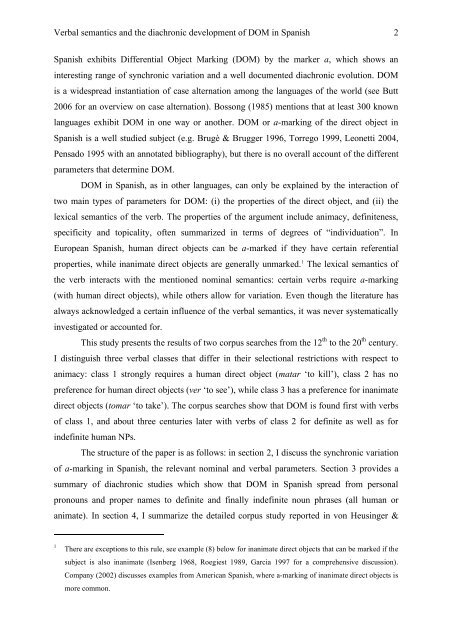Verbal Semantics and the Diachronic Development of Differential ...
Verbal Semantics and the Diachronic Development of Differential ...
Verbal Semantics and the Diachronic Development of Differential ...
You also want an ePaper? Increase the reach of your titles
YUMPU automatically turns print PDFs into web optimized ePapers that Google loves.
<strong>Verbal</strong> semantics <strong>and</strong> <strong>the</strong> diachronic development <strong>of</strong> DOM in Spanish 2<br />
Spanish exhibits <strong>Differential</strong> Object Marking (DOM) by <strong>the</strong> marker a, which shows an<br />
interesting range <strong>of</strong> synchronic variation <strong>and</strong> a well documented diachronic evolution. DOM<br />
is a widespread instantiation <strong>of</strong> case alternation among <strong>the</strong> languages <strong>of</strong> <strong>the</strong> world (see Butt<br />
2006 for an overview on case alternation). Bossong (1985) mentions that at least 300 known<br />
languages exhibit DOM in one way or ano<strong>the</strong>r. DOM or a-marking <strong>of</strong> <strong>the</strong> direct object in<br />
Spanish is a well studied subject (e.g. Brugè & Brugger 1996, Torrego 1999, Leonetti 2004,<br />
Pensado 1995 with an annotated bibliography), but <strong>the</strong>re is no overall account <strong>of</strong> <strong>the</strong> different<br />
parameters that determine DOM.<br />
DOM in Spanish, as in o<strong>the</strong>r languages, can only be explained by <strong>the</strong> interaction <strong>of</strong><br />
two main types <strong>of</strong> parameters for DOM: (i) <strong>the</strong> properties <strong>of</strong> <strong>the</strong> direct object, <strong>and</strong> (ii) <strong>the</strong><br />
lexical semantics <strong>of</strong> <strong>the</strong> verb. The properties <strong>of</strong> <strong>the</strong> argument include animacy, definiteness,<br />
specificity <strong>and</strong> topicality, <strong>of</strong>ten summarized in terms <strong>of</strong> degrees <strong>of</strong> “individuation”. In<br />
European Spanish, human direct objects can be a-marked if <strong>the</strong>y have certain referential<br />
properties, while inanimate direct objects are generally unmarked. 1 The lexical semantics <strong>of</strong><br />
<strong>the</strong> verb interacts with <strong>the</strong> mentioned nominal semantics: certain verbs require a-marking<br />
(with human direct objects), while o<strong>the</strong>rs allow for variation. Even though <strong>the</strong> literature has<br />
always acknowledged a certain influence <strong>of</strong> <strong>the</strong> verbal semantics, it was never systematically<br />
investigated or accounted for.<br />
This study presents <strong>the</strong> results <strong>of</strong> two corpus searches from <strong>the</strong> 12 th to <strong>the</strong> 20 th century.<br />
I distinguish three verbal classes that differ in <strong>the</strong>ir selectional restrictions with respect to<br />
animacy: class 1 strongly requires a human direct object (matar ‘to kill’), class 2 has no<br />
preference for human direct objects (ver ‘to see’), while class 3 has a preference for inanimate<br />
direct objects (tomar ‘to take’). The corpus searches show that DOM is found first with verbs<br />
<strong>of</strong> class 1, <strong>and</strong> about three centuries later with verbs <strong>of</strong> class 2 for definite as well as for<br />
indefinite human NPs.<br />
The structure <strong>of</strong> <strong>the</strong> paper is as follows: in section 2, I discuss <strong>the</strong> synchronic variation<br />
<strong>of</strong> a-marking in Spanish, <strong>the</strong> relevant nominal <strong>and</strong> verbal parameters. Section 3 provides a<br />
summary <strong>of</strong> diachronic studies which show that DOM in Spanish spread from personal<br />
pronouns <strong>and</strong> proper names to definite <strong>and</strong> finally indefinite noun phrases (all human or<br />
animate). In section 4, I summarize <strong>the</strong> detailed corpus study reported in von Heusinger &<br />
1<br />
There are exceptions to this rule, see example (8) below for inanimate direct objects that can be marked if <strong>the</strong><br />
subject is also inanimate (Isenberg 1968, Roegiest 1989, Garcia 1997 for a comprehensive discussion).<br />
Company (2002) discusses examples from American Spanish, where a-marking <strong>of</strong> inanimate direct objects is<br />
more common.

















